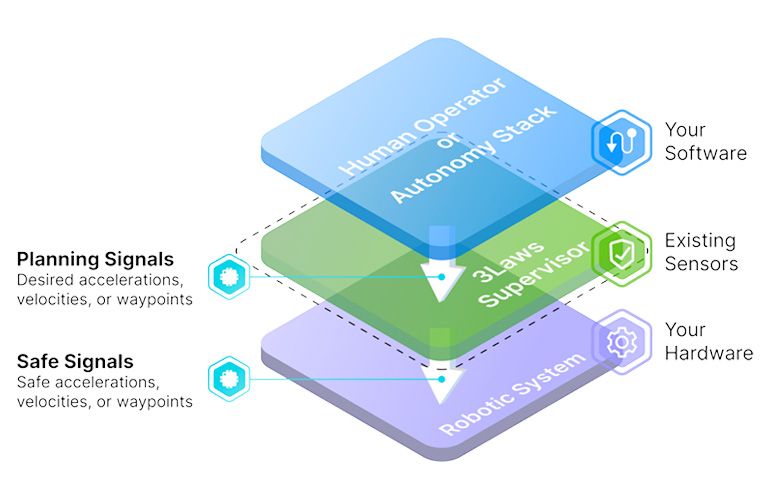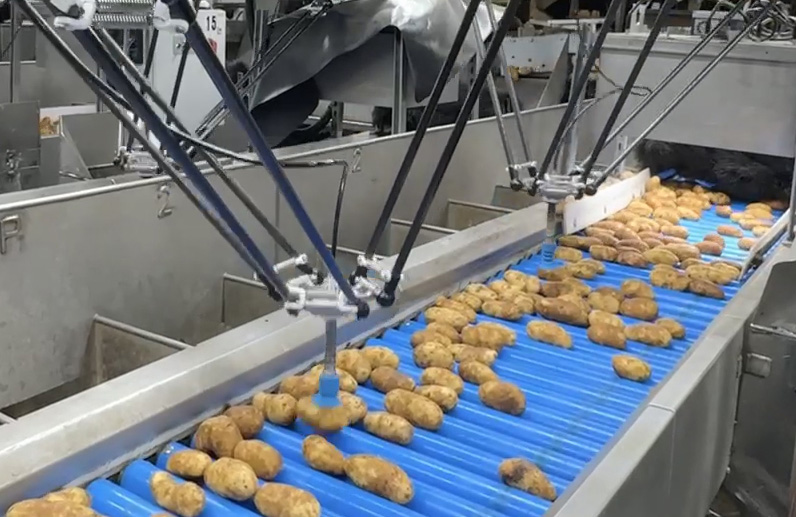
3Laws’ Supervisor is a software layer that operates between the autonomy stack and the robot to monitor and correct motion commands in real-time to deliver collision avoidance, geofencing, system stability, and other necessary outcomes. | Credit: 3Laws Robotics
3Laws Robotics has secured $4.1M in seed funding to expand the company and begin hiring to grow its engineering and customer support teams. TenOneTen led the round, which included participation from the Amazon Industrial Innovation Fund. All pre-seed investors have chosen to maintain or increase their ownership in this round.
“It’s a fantastic vote of confidence that all of our previous investors decided to reinvest without hesitation,” said Dr. Andrew Singletary, 3Laws co-founder and CEO. ”We’ve made significant advances over the past decade, and yet most machines are still not operating autonomously. Until now, there was no universal way of making a system safe and efficient and it’s incredibly challenging for autonomous systems to react safely to changes in real-time without bringing the system to a halt. 3Laws brings real-time guardrails to supervise AI-driven machines operating alongside people in dynamic environments. It’s a technological leap that allows both safety and system performance.”
3Laws Co-Founder Prof. Aaron Ames was a guest on The Robot Report Podcast earlier this year, where he explained how the company was formed from research developed in his CalTech laboratory.
From the lab to production
The company was founded by Prof Ames and some of his lab members who are responsible for creating the concept and developing/successfully demonstrating the implementations in a variety of systems. These include humanoid and quadruped walking robots, wheeled vehicles, autonomous trucks, quad-copters, watersport boats, and commercial/military aircraft. The 3Laws co-founders are all ex-students of Professor Ames.
At the core of the solution are Control Barrier Functions (CBF) which are mathematical formulations that constrain a physical system in motion to stay within a desired region of operation. By commanding the system back into what is defined as the desirable (or “invariant set”) region, certain properties similar to stability and safety can be provided. In theory, these properties are guaranteed as long as the system responds according to the mathematical model that is being used.
The CBF itself is a mathematical function that measures the distance from the system’s current condition to a boundary. The objective is to keep the system within the boundary. The definition of the boundary or barrier can be built to meet a wide variety of goals including collision avoidance, geo-fencing, falling over, exceeding angles-of-attack, violating accelerations, and multiple others. One of the main advantages of this formulation is that multiple objectives can be applied simultaneously.
“At Amazon, safety is our number one priority, and we believe that 3Laws’ software can help support the safety of a variety of automation systems deployed at Amazon,” said Franziska Bossart, head of the Amazon Industrial Innovation Fund. “We are excited to support the 3Laws team as they build software that has the potential to accelerate collaborative robotics and autonomous systems.”
A software-based dynamic safety function
Today, 3Laws said it has developed dynamic safety software that can be deployed universally on any autonomous system utilizing existing sensors. The company’s core product, Supervisor, is flexible, scalable, and can integrate into existing autonomy stacks without requiring modifications to the underlying structure.
Supervisor monitors signals from the existing autonomy software and modulates them, where necessary, to ensure dynamic safety in a deterministic and describable fashion. For development engineers, Supervisor removes corner cases and shortens development time. For operations managers, Supervisor ensures greater efficiency, improved reliability, and reduced risks. The end result is a system users can trust and deploy confidently.
This year, the company developed and released two versions of Supervisor. The basic Supervisor is designed to work out of the box with ROS-based mobile robots. It can be configured and deployed in a short period, according to 3Laws’ VP of Product Amir Sharif. The Supervisor Pro version can work with any control system but may require extensive integration by 3Laws to get it working with custom systems.
Prof Ames noted that Supervisor Pro was recently deployed onto an F16 fighter aircraft. On the aircraft, the system was successfully tested to help keep the aircraft inside a geo-fenced area, overriding pilot control. According to Ames, this is just one example of the possibilities for the use of Supervisor.
Who can use 3Laws Supervisor?
Robotic safety is critical to the implementation of any industrial, commercial, or consumer robotics solution. This includes use cases such as autonomous vehicles, last-mile delivery vehicles, drones, mobile robots, articulated robot arms, and quadrupeds. The Supervisor is designed to sit between either human control inputs or autonomous control inputs and the underlying robotic control system. It evaluates the setpoints requested and determines if the output will keep the system stable or send it unstable, all in real-time.
The 3Laws Supervisor is intended to prevent the delivery of a control signal that might cause an accident or failure of a dynamic system. This is different from an e-stop which cuts power to the robot amplifiers and stops the motors. The Supervisor can enact a controlled shutdown of a dynamic system. This type of safety control algorithm might be just what is needed to control a legged humanoid robot in any given situation.
While the Supervisor has not yet been safety certified against any existing safety regulations, Prof Ames believes the 3Laws product roadmap will reach this milestone in the future.

 1 month ago
22
1 month ago
22









 English (US) ·
English (US) ·